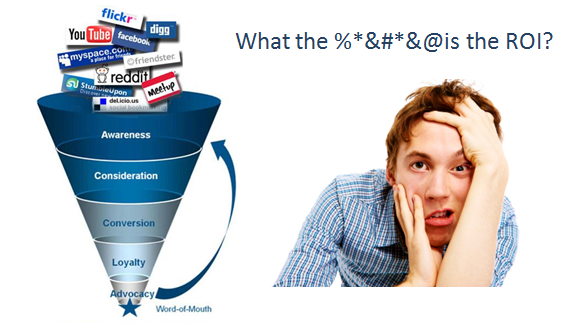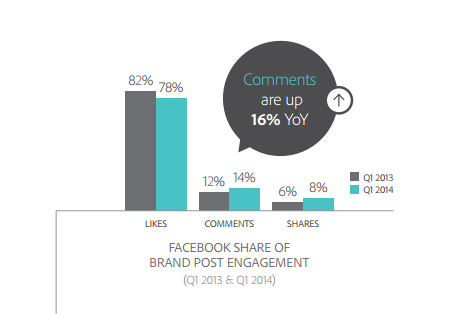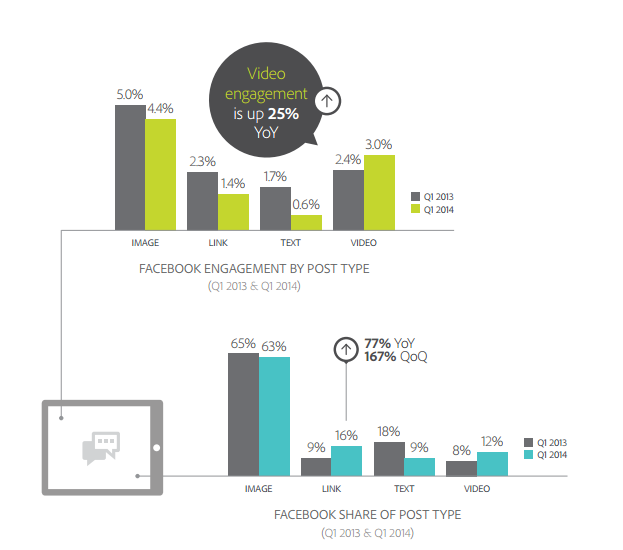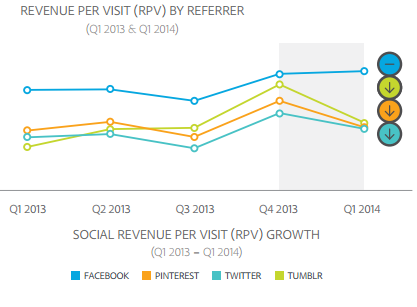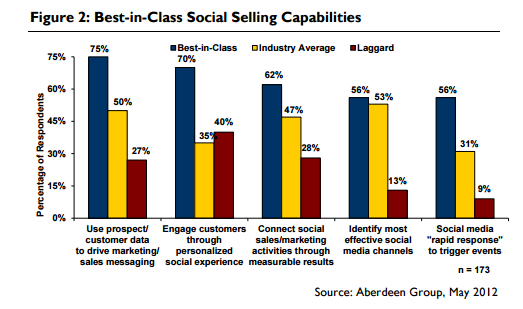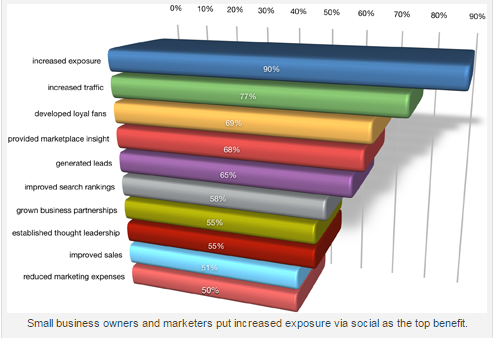There’s little doubt that measuring the impact of social media marketing on business ROI – leads, sales and revenue – is a hot topic of conversation. Numerous researchers have found that tying social media engagement to ROI is challenging to say the least for marketers across the board. While social media fortunately now allows for better, systematic measurement of the value of “word of mouth” social marketing and remarketing, attributing sales and revenue to social-engagement is not a slam dunk.
Looking first at the engagement metrics, we know that light touch “likes” vastly overshadow deeper engagement metrics (“comments” and “shares”). Adobe reports in their 2014 Social Intelligence Report the current volume gap and directional growth trends between “likes” and “comments” and “shares”:
So, since “likes” are free and easy and “shares” are fewer in number, what value do social engagement proxies like “likes” really play in the brand marketing toolkit? And as image and video sharing on social media platforms have increased in popularity (see below), is this really what we would call true “brand engagement”?
Social referrals to retail sites actually declined by 25% year over year between 2014 and 2013 as well as revenue per visit (Q1 vs Q1 2014 vs 2013) according to the Adobe report for all networks with the exception of Facebook:
So do social media engagement metrics represent movement down the purchase funnel or are they representative of an effect more similar to ad frequency, valuable for amplifying product and brand awareness and narrowing brand consideration sets as consumers recommend products and brands – but perhaps not as ideal for conversions to sales? Are social media networks inherently SOCIAL not buying networks? Are “likes” and “shares” highly correlated with brand mentions and net promoter scores? Is “social selling” still just a buzzword?
The answer appears to be that social selling is in fact, not just a buzzword and that companies which pay attention to customer relationships via social media are in fact doing better.
According to the CMO and Aberdeen Group’s 2015 CMO’s Guide to the Social Landscape, users of social selling are 30% more likely to see total team attainment of their sales quotas than were others (64% vs. 49% sales quota attainment). Aberdeen’s 2012 research with 173 B-to-B companies separated “best-in-class” companies who reached or exceeded sales quotas, increased sales year-over-year and average deal size vs “industry average” and “laggards” reported more investment in social selling strategies:
Other evidence from the Social Media Examiner’s seventh annual Social Media Marketing Industry Report, a survey of 3,720 marketers, business owners and solopreneurs from the U.S. shows that small businesses rely on social media primarily for exposure but are also using social networks for leads:
New social media functionality is aimed directly at this critical relationship between social activity and sales especially in retail businesses. Pinterest is launching their “buy it” button and Instagram is expanding their “shop now” ads which will be linked to online e-commerce platforms. These new features should improve the ROI of past investments brands have made to build their social audiences.
So what are the best ways a company can leverage social media audiences, features and interest to deliver better sales? Her e are 5 tips:
- Build a closer collaboration between Marketing and Sales. Marketing builds the e-list, Sales leverages those opted-in relationships to generate warm leads. Social media is one more channel to nurture these prospects. And Marketing can use social to test messaging, language, incentives and proof points which position brands (and promotions) – better.
- Develop a more personalized approach. Use the language of your customers. Thank them for tips and new information. Use social bookmarking tools to save these treasures. Share user content when valuable and new/unique.
- Be timely. Take current events relevant to your brand’s space and turn them into questions which engage your audience. Start a conversation then keep contributing. Build a conversation into a theme (Instagram), a board (Pinterest) and a list of followers.
- Amplify everything. Like every comment, share. Share selected comments by customers on one channel (e.g. Facebook), with users on other channels (Twitter, Linkedin) and Pinterest…Instagram. Repost content multiple times.
- Productize promotional campaigns. Create branded images promoting the promotion for social posting over the course of the campaign. Put incentives for participation behind gates to capture interest levels. Use separate promo codes/hashtags to track across channels and measure activity. Make these different from promo codes used offline and in-store.
Need help with a strategy to tie social media marketing to social selling and ROI? Just call us!

